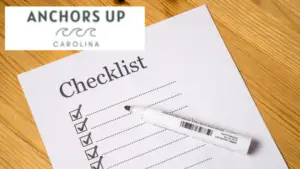One of the smartest measures of action to take before heading out on the water is following a checklist. A checklist will ensure that you have all necessary safety equipment onboard and that everything is in working condition. As a captain, I followed checklists on a consistent basis. Fortunately, I never ran into any serious issues while delivering vessels across open waters. Here is what you need to know about a boat safety checklist.
How To Make A Boat Safety Checklist
Without question, you can purchase a checklist specific to boats. However, they will not be specific to your vessel or items onboard. Remember, each boater keeps specific gear on the vessel, and not all are alike.
With that being said, it is best to make your own checklist. The best way to make a checklist is to write out the following.
- Write down all of the safety equipment that is kept onboard (life jackets, throwable devices, life rafts, etc.)
- On the list include testing equipment (bilge pump, navigation lights, horn, drain plug, engine trim, VHF radio, marine electronics, and more)
Type The List Checklist
Importantly, you’re not going to want to use a standard sheet of printer paper when making a checklist. The sheet will require being of thicker stock so that it does not bend. A flimsy sheet will not last for extended periods of time and will be challenging to write on.
I suggest using cardstock. Cardstock is far more sturdy compared to standard printer paper. However, make sure that your printer is capable of feeding cardstock through the rollers while printing.
Considering you have already jotted down notes, type up a list of all of the items needing to be checked before departing the dock. I suggest adding boxes next to each task so that it can be marked with an erasable marker.
Print The Checklist
Once the list is complete, it can be sent to the print. Ensure that the printer has plenty of ink so that is not challenging to read.
Once the checklist is printed, allow the ink to dry completely before handling. You’re not going to want to smear the ink with the tips of your fingers.
Laminate The Checklist
After the document has been printed and allowed to dry, it can be laminated. Laminating the checklist is highly beneficial for a number of reasons.
- A laminated document will not become damaged as a result of moisture
- The checklist can be written on with an erasable marker
- Stowing the checklist laminated will prevent it from being crumpled up
Store The Checklist Consistently In One Location
Unquestionably, you’re going to need to keep the checklist on the boat at all times. Never put the list in a location where it can end up in your vehicle and go into your home.
With that said, find a location on the boat where the checklist can be stowed when not in use. Remember, the boat safety checklist should never be bent or folded. Instead, find a spot where it can lay flat. I suggest utilizing a storage compartment at the helm or near the helm. Always return the checklist to the same location once you are done.
How To Use The Boat Safety Checklist
After the checklist is typed, printed, and laminated, it is time to put it to use. Importantly, you’re going to want to make using the checklist a routine each time you head to the boat before leaving the dock.
Once you either arrive at the marina or are preparing to launch the boat, it is time to review the checklist. Without question, you’re going to want to have an erasable marker on hand.
Grab the checklist from the storage location along with the marker. Once both are on hand, walk through the boat and ensure that all items are either onboard or in working condition.
Avoid skipping through items to test on the list. You don’t want to find out that hard way that vital equipment isn’t working or safety gear is missing.
Lastly, once you’re done checking off the boxes, wipe the laminated surface clean. After it is clean, stow the checklist in a safe location.
Follow A Boat Safety Checklist
One of the best ways to remain safe while boating is to follow a safety checklist. I highly recommend creating a custom list specific to your vessel. Boating is fun, but you must remain conscious of onboard equipment and safety gear. Stay vigilant to ensure that you will not be unprepared in the event of an emergency.







